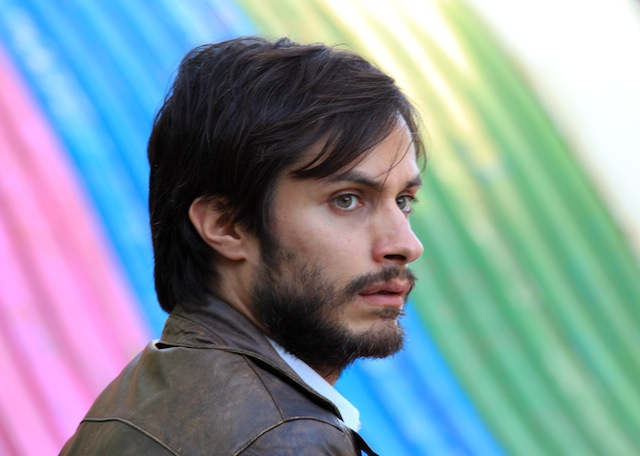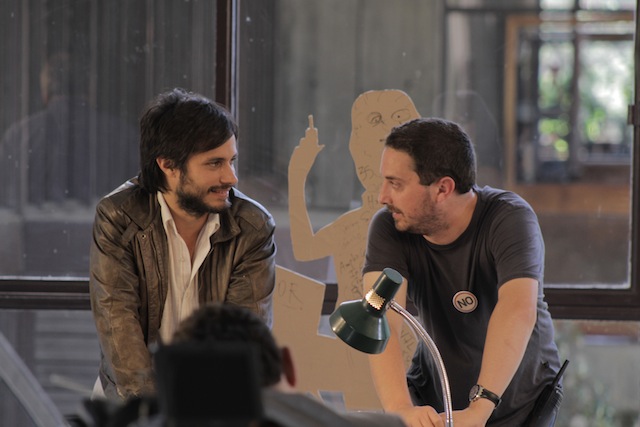CHICAGO – Patrick McDonald of HollywoodChicago.com appears on “The Morning Mess” with Dan Baker on WBGR-FM (Monroe, Wisconsin) on March 21st, 2024, reviewing the new streaming series “Manhunt” – based on the bestseller by James L. Swanson – currently streaming on Apple TV+.
Taut, Witty ‘No’ Celebrates Unorthodox Marketing of Freedom
 Rating: 4.0/5.0 |
CHICAGO – The controversy swirling around Pablo Larraín’s Oscar-nominee “No” is typical of the outrage garnered by many a historical drama. Since the film focuses solely on one crucial segment of the activism that ousted Chilean dictator Pinochet during the 1988 plebiscite, some viewers will complain that not every hero in the tale is represented. Of course, that’s what encyclopedias are for.
Just as Spielberg’s “Lincoln” brilliantly explored the complicated, occasionally deceptive efforts that were vital in achieving slavery’s abolishment with the passage of the 13th Amendment, Larraín’s “No” focuses on the marketing campaign that built support for the anti-Pinochet movement. Both films are invaluable portraits of tenacious trailblazers who were able to win over the hearts and minds of timid voters. Yet whereas “Lincoln” was shot in widescreen, painterly compositions, “No” adopts the exact style of the game-changing ads its film celebrates.
One of the complaints some Chileans have had with the picture is that its blending of archival footage and staged scenes is so seamless, the line separating fact from fiction is hopelessly blurred. Yet the film makes no real attempt at passing itself off as a documentary. The casting of world-renowned actor Gael García Bernal in the lead role is a blatant indicator that historical accuracy will not be the film’s chief goal. Loosely based on Antonio Skármeta’s play, “The Plebiscite,” Bernal stars as advertising executive René Saavedra, a composite character molded after publicist José Manuel Salcedo and ad exec Enrique García (both men make brief cameos in the film). After Pinochet is forced to authorize a vote on the extension of his rule, each side is granted 15 minutes of air time a day to televise their campaign ads. Leaders of the NO campaign make a bold choice in recruiting Saavedra to assist them in gaining the support of an electorate too scared to vote against such a formidable monster. Pinochet’s atrocious blood-soaked history of violence against his own people certainly gives the NO group enough ammunition to fuel their dissent, but Saavedra’s familiarity with American marketing techniques ends up taking the campaign in an entirely different direction.

Gael García Bernal stars in Pablo Larraín’s No.
Photo credit: Tomás Dittburn, Courtesy of Sony Pictures Classics
Sure, it can be argued that Saavedra is the sort of fictional photogenic underdog tailor-made for celebrities to inhabit onscreen, but Pedro Peirano’s script doesn’t just make the character more attractive. It alters the nature of his motive. Instead of a 50-something political idealist, Peirano’s version of Saavedra is a 30-something businessman with little interest in politics. He views the voters as he would any target demographic. If any aspect of his ads will fail to seduce his audience, they are doomed to failure, regardless of how honest or unflinching they may be. What’s most important is the bottom line, and in this case, the line is happiness. That’s the promise Saavedra aims to make with his ads, declaring that a NO vote will bring the Chilean people a euphoric release from their despair.
Of course, this approach doesn’t satisfy those personally impacted by Pinochet’s crimes, and there are some drolly funny moments when Saavedra’s montages of cartoonish jubilation elicit baffled reactions (“What the hell is a mime doing in my ad?!” exclaims one client). Bernal delivers one of his best performances, deftly conveying Saavedra’s determination to achieve his goal in light of insurmountable odds. Not only is the YES campaign outspending NO 30 to 1, but cynical Pinochet adversaries (including Saavedra’s estranged wife) are refusing to participate in what they believe to be a rigged game.
“No” is the culmination of Larraín’s trilogy exploring dictatorship: its brutality (2008’s “Tony Manero”), its origins (2010’s “Post Mortem”), and in this case, its destruction. All three pictures were lensed by the magnificent cinematographer Sergio Armstrong (“The Maid”), who frankly outdoes himself in “No.” He shot the entire film on analog video cameras, confining the footage to a 4:3 aspect ratio that heightens the suspense in several claustrophobic sequences. There’s an especially memorable moment when Saavedra awakens to discover that members of Pinochet’s secret police, the DINA, have broken into his house. Though the intruders remain off-camera, a toy train eerily chugs along its circular track, suggesting that the DINA turned it on to intimidate Saavedra. Armstrong places the camera on the ground as the train continues to encircle it, intensifying the audience’s paranoia of what lies just beyond the frame.

Gael García Bernal and director Pablo Larraín on the set of No.
Photo credit: Tomás Dittburn, Courtesy of Sony Pictures Classics
American audiences will undoubtedly see obvious parallels between the YES and NO campaigns and the policies of Democrats and Republicans. Saavedra’s boss, Lucho (Alfredo Castro), ends up working for Pinochet’s advisory board, inspiring Saavedra to observe that bosses tend to support YES, while employees favor NO. Indeed, much of the dialogue spouted by Pinochet’s minions (who believe “anybody…not everybody…can be rich”) could’ve easily been taken from any RNC speech. Yet “No” is far richer and more rewarding than any caricature-laden propaganda. Though Saavedra’s approach proves to be successful, his judgment isn’t impeccable, particularly when he deems an ad featuring the mothers of detained children as “too ugly.” His viewpoint may not be everyone’s cup of tea, but its objective sense of public opinion is invaluable. Sometimes freedom must be acquired with righteous fury. Sometimes it can be earned with a jingle.
 | By MATT FAGERHOLM |


